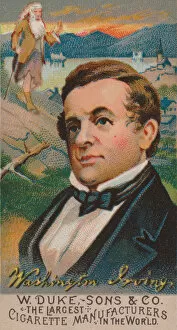Irving Washington Collection
Irving Washington, a name that resonates with literary brilliance and timeless tales
All Professionally Made to Order for Quick Shipping
Irving Washington, a name that resonates with literary brilliance and timeless tales. Born in 1783, this American author left an indelible mark on the world of literature. Known for his captivating stories and vivid imagination, Irving Washington's legacy continues to enchant readers even today. One of his most famous works is "Rip Van Winkle, " first published in 1820. This tale of a man who falls asleep for twenty years has become synonymous with the concept of timelessness itself. The iconic illustrations by John Quidor and James Hamilton further brought Rip Van Winkle's story to life, immortalizing it in our collective consciousness. In portraying the character of Rip Van Winkle on stage, actor Mr. Hackett captured the essence of Irving's creation during the early 1830s. Henry Inman beautifully depicted him in costume as Rip Van Winkle, showcasing how deeply this character had permeated popular culture. Washington Irving himself was not only a talented writer but also possessed a striking presence captured by artists such as Charles Loring Elliott and Daniel Huntington. Their portraits depict him at different stages of his life - one from around 1860 showing wisdom etched upon his face while another from circa 1840 captures his youthful spirit. Another masterpiece inspired by Irving's storytelling prowess is "The Headless Horseman Pursuing Ichabod Crane. " Painted by John Quidor in 1858, this haunting image perfectly encapsulates the eerie atmosphere created within "The Legend of Sleepy Hollow. " "The Return of Rip Van Winkle" painted by John Quidor in 1849 adds another layer to Irving's narrative universe, exploring what happens when someone returns after being lost to time. Even long after his passing, Washington Irving continued to be celebrated through various mediums like cigarette cards featuring him as part of Duke brand cigarettes' Great Americans series in 1888 – testament to his enduring influence.

















